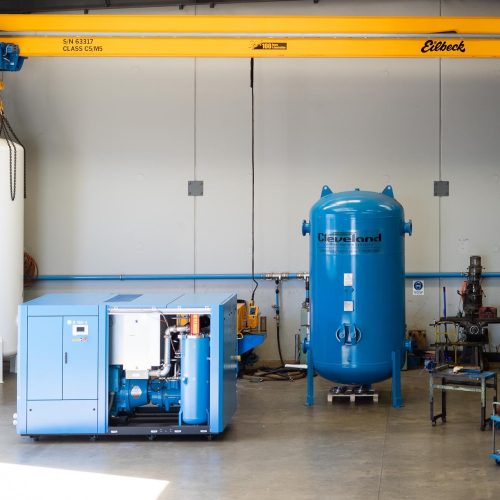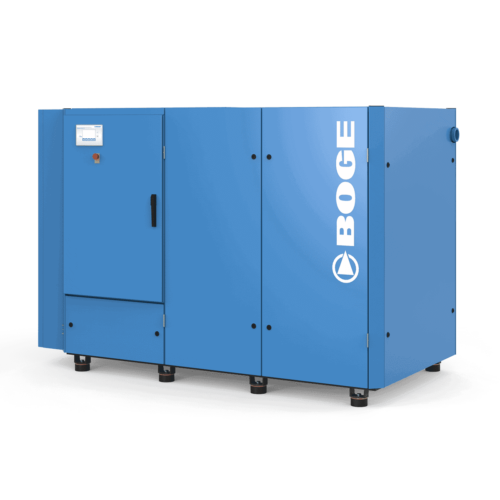Comparing a Wet vs Dry Air Receiver Tank
Air receivers, also known as air tanks or receiver tanks, are essential components in any compressed air system. These air storage tanks can either be classified as wet air receivers or dry air receivers, based on their placement in the system and the kind of air they handle.
Wet air receivers are typically installed between the air compressor and the air dryer in a compressed air system. The air entering a wet air receiver is still saturated with moisture, hence the name. The moist, compressed air from the air compressor is stored in the wet air receiver tank, which allows the air to cool. The cooling process causes a significant amount of the moisture in the air to condense, which can then be drained away. This process reduces the load on the air dryer, thus improving its efficiency and lifespan. Moreover, wet air receivers also help in stabilising pressure fluctuations, a key factor in maintaining the efficacy of the compressed air system.
Dry air receivers, on the other hand, are placed after the air dryer in the compressed air system. The air in a dry air receiver, or dry storage tank, has already been dehumidified, which is why it’s referred to as ‘dry’. These tanks provide a reserve of clean, dry air that can be used when the demand exceeds the capacity of the compressor. Dry air receivers are vital in maintaining a steady pressure downstream, avoiding pressure drops that could otherwise disrupt operations.
In conclusion, both wet and dry air receivers play a pivotal role in the efficient operation of a compressed air system. They offer several benefits, including improved efficiency, enhanced reliability, moisture control, and pressure stabilisation. The choice between a wet and dry air receiver depends on the specifics of the system and the unique requirements of the operation.
Advantages of wet compressed air storage
The key advantage of a wet compressed air storage system, particularly one equipped with a robust wet air receiver tank or wet storage tank, is its role in managing and reducing the load on the compressor. The wet air tank acts as a buffer, taking in the air during the compressor’s on-cycle periods and continually releasing it even when the compressor is in the off-cycle. This essentially balances the workload of the compressor, extending its lifespan, and minimising wear and tear.
Furthermore, the wet air storage system also plays a critical role in the cooling and condensation process of the air coming from the air compressor. The incoming hot air, when stored in the wet tank, cools down naturally over time. This cooling process leads to the condensation of the moisture in the air, which can then be effectively drained from the tank. Thus, the air that exits the wet air receiver tank is not only cooler but also significantly drier, which is beneficial for many applications. Additionally, this process also decreases the load on the compressed air dryer. This not only enhances the air dryer’s efficiency but also extends its operational life.
The wet air receiver also provides the air receiver tank operators the advantage of better control over the air pressure. This is due to the tank’s volume, which means that significant fluctuations in the air pressure can be effectively managed. As a result, it provides a more stable air supply at a consistent pressure, which is critical for many industrial processes.
In conclusion, the advantages of wet compressed air storage make it a favoured choice in many industries requiring high volumes of compressed air. From managing the compressor’s load, providing a cooler, drier air output, offering better pressure control, to being cost-effective, the benefits of a wet air receiver are numerous and significant. However, it is essential to remember that the choice between a wet and dry air receiver will ultimately depend on the specific needs and requirements of your application.
Advantages of dry compressed air storage
Dryer air storage provides a reserve of air that can be rapidly deployed when the compressed air demand is greater than the air compressor’s supply.
Dry air storage offers benefits when it comes to the performance of your air tools and machinery. Moisture in the stored air can lead to rust and corrosion, which can quickly degrade the performance of tools and equipment. By using dry air storage, you can prolong the lifespan of your tools and equipment, ensuring they function optimally for longer periods as the air is ready for use and pre-treated appropriately using dryer and filtration.
Finally, dry air storage allows for more flexible and convenient usage. Unlike wet air storage which requires regular draining to manage moisture, dry air storage systems require less maintenance and can store air for prolonged periods without the risk of moisture build-up. This allows for greater flexibility in terms of when and how the compressed air can be used.
In conclusion, dry compressed air storage offers a host of benefits including improved efficiency, reduced maintenance, and enhanced equipment lifespan. Whether you are running a small workshop or a large industrial facility, the advantages of dry air storage make it a worthwhile investment.
FAQs
When compressed air enters the tank, it displaces the air already inside, reducing the internal pressure. The compressed air is stored at a higher pressure until it is needed.
An air receiver tank can help maintain a dry air supply by allowing moisture and contaminants to settle out of the compressed air. This helps prevent water and particles from entering the air lines and downstream equipment.
During periods of increased air demand, an air receiver tank can supply a larger volume of compressed air than the compressor alone. This allows for short-term peak air demands to be met without overloading the compressor.
An air receiver helps in improving the efficiency of an air dryer by providing a buffer between the compressor and the air drying system. This buffer allows water vapour to condense out of the air before it enters the drying system, resulting in better performance and reduced load on the dryer.
A compressed air storage tank, whether it's a wet air receiver or a dry storage tank, aids in managing and stabilising the system pressure. This is crucial in avoiding pressure drops and ensuring a consistent air supply, which is particularly important in industrial processes that require stable air pressure.
While a compressed air system can operate without an air receiver tank, its absence can lead to increased stress on the compressor and potential pressure fluctuations. The use of a compressed air tank, whether wet or dry, is recommended for optimal system performance and longevity.
Wet air receiver tanks assist in managing excess heat by allowing the hot, moist air from the compressor to cool down, which reduces the temperature of the air and aids in moisture condensation.


